
History of the Jefferson Memorial
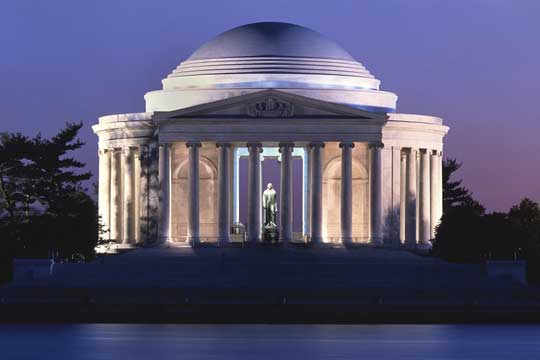
Jefferson Memorial. Credit: Library of Congress, Carol M. Highsmith Archive.
Thomas Jefferson (1743-1826) composed an epitaph for his own tomb, listing what he considered to be his three greatest accomplishments: "Author of the Declaration of American Independence, of the Statute of Virginia for Religious Freedom, and Father of the University of Virginia."
Jefferson, a scientist and architect as well as a statesman, failed to mention that he had also served as third president of the United States. After his death on July 4, 1826, Jefferson's reputation grew slowly. It would be more than a century before he was honored with this memorial, dedicated in 1943.
In its 1902 plan for the Mall, the McMillan Commission suggested the Tidal Basin as the site for a great monument to an unspecified person. The proposed monument would terminate the cross axis of the Mall, an imaginary north-south line connecting the Tidal Basin site with the grounds of the Washington Monument and the White House.
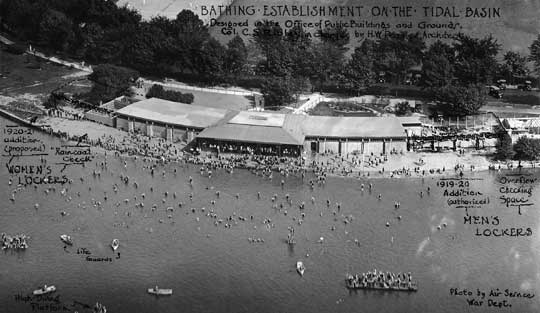
Between 1918 and 1925, a popular bathing beach occupied the present site of the Jefferson Memorial. Credit: National Archives.
In the 1920s, a monument to President Theodore Roosevelt was planned for this important site, and a design by John Russell Pope was selected. Pope's scheme had two semicircular arrays of columns surrounding a large fountain, but Congress never funded its construction.
Franklin Delano Roosevelt, a Democrat first elected president in 1932, was a great admirer of Jefferson and his interest led to the establishment of the Jefferson Memorial. It helped that the Democrats, who had come to see Jefferson as the father of their party, now controlled Congress as well.
Congress created the Thomas Jefferson Memorial Commission in 1934 to plan and construct an appropriate monument. Citing Jefferson's interest in classical architecture, the commission decided that the memorial should be classical in style and hired John Russell Pope, the preeminent American classical architect. The commission favored the Tidal Basin as the only suitably important site left on the Mall.
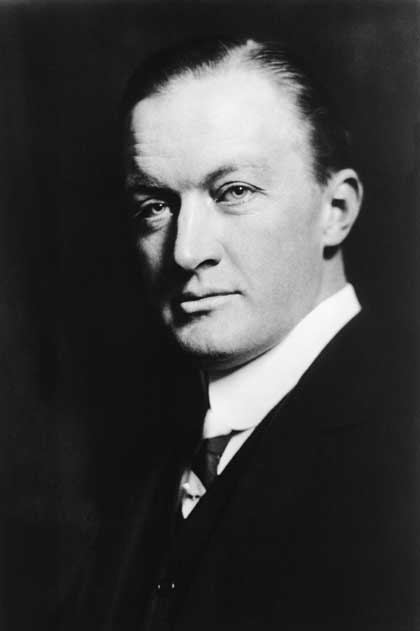
John Russell Pope (1874-1937) designed the Jefferson Memorial, as well as the National Gallery of Art and several other important Washington buildings. Credit: Library of Congress.
Pope devised plans for the Tidal Basin and three alternative sites. His scheme for the Tidal Basin, resembling the one in the McMillan Plan, had a colossal open pantheon with a statue of Jefferson inside, while the basin would have been reshaped into a rectangle. The commission favored this option, but asked Pope to scale it down, since it would have been far too costly to build.
In December 1936, Pope returned to the memorial commission with two designs. The commission accepted Scheme A, but when it presented the plan to the Commission of Fine Arts (CFA) the following March, it was rejected. Since 1910, all additions to the Mall must be submitted to the CFA, which principally comprises artists and architects appointed by the president. The CFA was unhappy that there had been no competition; it believed that Pope's design was an unimaginative recycling of an ancient building and too similar to the Lincoln Memorial. Furthermore, Pope's plan would require destroying nearly all of the cherry trees on the Tidal Basin.
Pope's scheme, once made public, was savaged by a vast array of prominent architects and critics. Beaux-Arts classicism, at its height when the McMillan Commission presented its plan for the Mall in 1902, had now passed out of fashion. Modernism had taken its place, but Pope believed in readapting a few ancient prototypes, rather than radical innovation. Critics called his design for the Jefferson Memorial pompous and uninspired, "applied archeology" that didn't capture Jefferson's spirit or imagination. Some criticized its similarity to the National Gallery of Art, also designed by Pope and based on the Roman Pantheon.
Pope died in August 1937, and his work was continued by two associates, Otto R. Eggers and Daniel P. Higgins, who produced some additional designs. The CFA preferred an adaptation of a scheme that Pope had created in the 1920s for the proposed memorial to Theodore Roosevelt, and the memorial commission agreed to accept it as a compromise, although it still preferred the pantheon.
Pope's widow, however, refused to grant permission to modify his work. In March 1938, the memorial commission reversed itself and went back to the pantheon design, claiming that it had not been aware that the modified Roosevelt Memorial design was in fact a rehash of an old design. The memorial commission submitted the pantheon to the CFA yet again—the Tidal Basin would be left intact—and again it was rejected. At the end of March, the memorial commission announced that it was going forward with the pantheon anyway, without CFA approval, and Congress provided funds to begin construction.
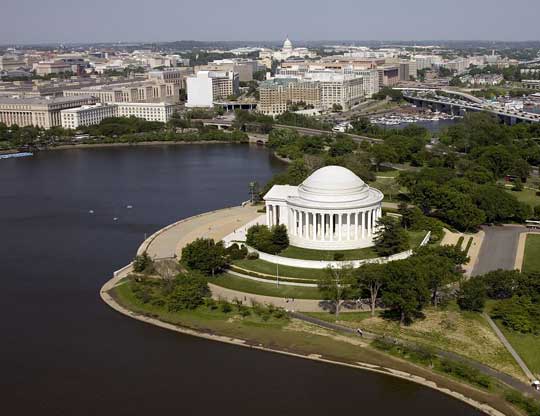
Jefferson Memorial and its setting on the Tidal Basin. Credit: Library of Congress, Carol M. Highsmith Archive.
In September 1938 Frederick Law Olmsted Jr. was hired to plan the landscaping around the memorial, and in December, President Roosevelt presided over the groundbreaking ceremony. Protesters opposed destruction of the cherry trees on the site, but progress was only briefly delayed.
The foundations were constructed in 1939. The memorial was built on recent landfill, and piles were sunk to bedrock. The cornerstone was set in November 1939. Work continued in spite of World War II, and the memorial was completed in early 1942, when it was opened to the public. It is 184 feet in diameter. The exterior is made of white marble from Vermont, on a granite base. There are 54 Ionic columns; the 38 exterior columns are 41 feet high.
The rotunda is 92 feet tall. The walls are made of Georgia marble; the floor is pink Tennessee marble, and the interior of the dome is Indiana limestone. The room has four openings, each with four columns. Between the openings are four panels with excerpts from Jefferson's writings.
The memorial was well underway before a sculptor for the Jefferson statue was selected. In July 1939, a jury selected six entrants from a field of 101 competitors. After several rounds of competition, sculptor Rudulph Evans of New York was chosen in October 1941.
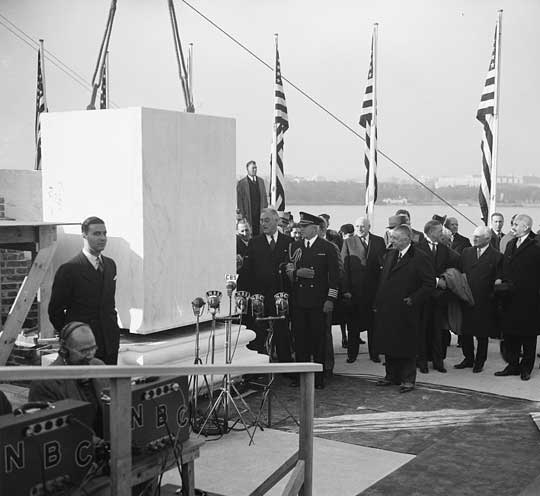
Franklin D. Roosevelt set the cornerstone in November 1939. It can be seen today just inside the entrance on the right. Credit: Library of Congress.
The Thomas Jefferson Memorial was dedicated by President Roosevelt on April 13, 1943, the bicentennial of Jefferson's birth. The Declaration of Independence was on display in the memorial, guarded by four marines. Evans's sculpture of Jefferson was represented by a full-sized plaster cast painted to resemble bronze, since a wartime shortage of the metal (10,000 pounds were required) prevented casting of the statue.
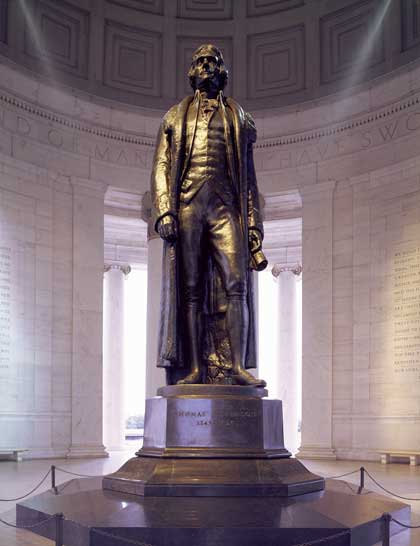
Statue of Thomas Jefferson by Rudulph Evans. Credit: Library of Congress, Carol M. Highsmith Archive.
The sculpture was completed after the war and installed in the rotunda in April 1947. It is 19 feet tall and stands on a black granite base. Jefferson is depicted in a relaxed posture, wearing a fur-trimmed coat and holding a scroll in one hand. The sculpture is said to be a good likeness, but it lacks the dynamism of Daniel Chester French's statue of Lincoln.
Adapted with permission from The Washington National Mall, by Peter R. Penczer, Oneonta Press, Arlington, Va.: 2007.
Copyright © Peter R. Penczer 2016